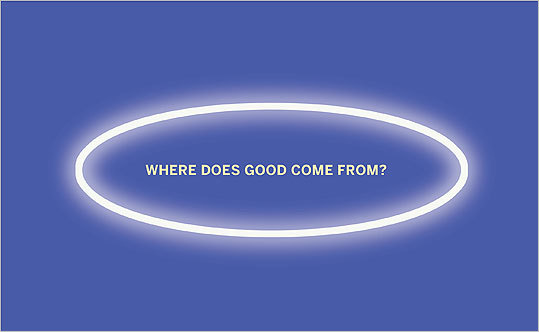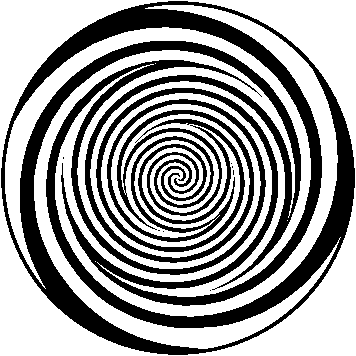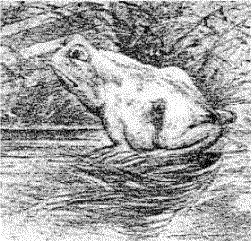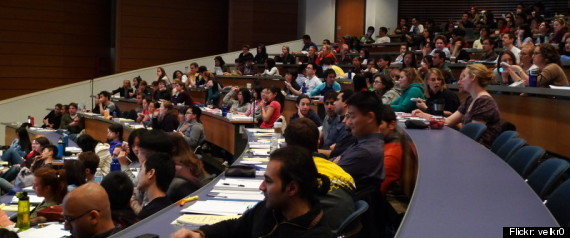Recently in Comment Category
Edward Reid Sings Nursery Rhymes to Run backing... by UCANLEARNPOKERdotCOM x
What does this tell us about expectations?
What does this tell us about the relationship between auditory perception and music?

What Wilson is trying to do, late in his influential career, is nothing less than overturn a central plank of established evolutionary theory: the origins of altruism. His position is provoking ferocious criticism from other scientists. Last month, the leading scientific journal Nature published five strongly worded letters saying, more or less, that Wilson has misunderstood the theory of evolution and generally doesn't know what he's talking about. One of these carried the signatures of an eye-popping 137 scientists, including two of Wilson's colleagues at Harvard.
http://www.boston.com/bostonglobe/ideas/articles/2011/04/17/where_does_good_come_from/?page=full
(Thanks to Osman for sending)

On Oct. 27 in Seerly Hall, University of Northern Iowa associate professor of psychology Otto MacLin gave a presentation titled, "How the Brian Lies and Misrepresents the 'Real World.'" MacLin explained with numerous visual and demonstrations how the brain lies so it can attempt to explain its surroundings.
http://www.northern-iowan.org/uni-psychology-professor-shows-how-the-brain-lies-1.2389321?MMode=true

What does this tell us about Sensation & Perception?
http://www.guardian.co.uk/science/2011/apr/14/expensive-wine-cheap-plonk-taste

What does this tell us about sensation & perception?
See more of these ads at - http://www.hongkiat.com/blog/creative-ads-from-att-wireless-international-roaming/
(Thanks to Laura for sending)

Greg Bryant - http://gabryant.bol.ucla.edu/
McGurk effect - http://www.youtube.com/watch?v=ypd5txtGdGw
Scientific American Pod Cast - http://www.scientificamerican.com/podcast/episode.cfm?id=auditory-illusions-10-04-25
Quickening beat & Sound for under 20 - http://listverse.com/2008/02/29/top-10-incredible-sound-illusions/
What does this video tell us about the perception of time?
What does this video tell us about Gestalt?

"Using multiple layers of clear glass, Canada based David Spriggs and Chinese born Xia Xiaowan, transform flat artwork into 3D sculptures. Viewers are treated to different shifting perspectives of the works based on where they stand in the art space. Spriggs work revolves around powerful explosive imagery, often resembling storms, cosmic blasts or firework like explosions. Xiawan's "spatial paintings," which often feature distorted figures, are drawn individually using colored pencil on tinted glass. Only when these pieces are combined on their floor racks do the images create the whole hologram like effect."
http://www.visualnews.com/2011/01/04/3d-paintings-on-panes-of-glass/

"If you're one of those people who likes to ponder things while looking out a frosty window on a cold winter day, these pictures will clear up one of those long standing wonders: each snowflake really IS unique. Some look like roman columns, others circuit boards or spaceships. Taken under high magnification using a microscope, these images bring a fragile and beautiful world into view."
http://www.visualnews.com/2010/12/20/snowflakes-up-close-a-small-fragile-world/
check this oneout too
http://www.visualnews.com/2011/03/29/the-up-close-world-of-pollen/
Smooth Pursuit:
Abnormal Smooth Pursuit:
Reading Saccades:
Motion Blindness (Akinetopsia) from Ian Kammer on Vimeo.
Akinetopsia from Ian B on Vimeo.
THE TRICK IS TO FIND THE MAN IN THE COFFEE BEANS:
This is bizarre - after you find the guy - it's so obvious.
Once you find him - it's embarrassing, and you think,
'Why didn't I see him immediately?'

How can we explain this from a Sensation & Perception perspective, based on what we have been learning from class?
A Short Neurological Test
1- Find the C below..
Please do not use any cursor help.
OOOOOOOOOOOOOOOOOOOOOOOOOOOOOOO
OOOOOOOOOOOOOOOOOOOOOOOOOOOOOOO
OOOOOOOOOOOOOOOOOOOOOOOOOOOOOOO
OOOOOOOOOOOOOOOOOOOOOOOOOOOOOOO
OOOOOOOOOOOOOOOOOOOOOOOOOOOOOOO
OOOOOOOOOOOOOOOOOOOOOOOOOOOOOOO
OOOOOOOOOOOOOOOOOOOCOOOOOOOOOOO
OOOOOOOOOOOOOOOOOOOOOOOOOOOOOOO
OOOOOOOOOOOOOOOOOOOOOOOOOOOOOOO
OOOOOOOOOOOOOOOOOOOOOOOOOOOOOOO
OOOOOOOOOOOOOOOOOOOOOOOOOOOOOOO
2- If you already found the C, now find the 6 below.
99999999999999999999999999999999999999999999999
99999999999999999999999999999999999999999999999
99999999999999999999999999999999999999999999999
69999999999999999999999999999999999999999999999
99999999999999999999999999999999999999999999999
99999999999999999999999999999999999999999999999
3 - Now find the N below. It's a little more difficult.
MMMMMMMMMMMMMMMMMMMMMMMMMMMMNMM
MMMMMMMMMMMMMMMMMMMMMMMMMMMMMMM
MMMMMMMMMMMMMMMMMMMMMMMMMMMMMMM
MMMMMMMMMMMMMMMMMMMMMMMMMMMMMMM
MMMMMMMMMMMMMMMMMMMMMMMMMMMMMMM
This is NOT a joke. If you were able to pass these 3 tests, you can cancel your annual visit to your neurologist. Your brain is great and you're far from having a close relationship with Alzheimer.
Congratulations!
eonvrye that can raed this rsaie your hnad.
To my 'selected' strange-minded friends:
If you can read the following paragraph, forward it on to your friends and the person that sent it to you with 'yes' in the subject line.
Only great minds can read this
This is weird, but interesting!
If you can raed this, you have a sgtrane mnid too
Can you raed this? Olny 55 plepoe out of 100 can.
I cdnuolt blveiee that I cluod aulaclty uesdnatnrd what I was rdanieg. The phaonmneal pweor of the hmuan mnid, aoccdrnig to a rscheearch at Cmabrigde Uinervtisy, it dseno't mtaetr in what oerdr the ltteres in a word are, the olny iproamtnt tihng is that the frsit and last ltteer be in the rghit pclae. The rset can be a taotl mses and you can still raed it whotuit a pboerlm.. This is bcuseae the huamn mnid deos not raed ervey lteter by istlef, but the word as a wlohe. Azanmig huh? Yaeh and I awlyas tghuhot slpeling was ipmorantt! If you can raed this forwrad it
FORWARD ONLY IF YOU CAN READ IT
Forward it & put 'YES' in the Subject Line, and also forward to me.
(Actually don't forward this - Otto)
(Thanks to Peggy for sending)
What does this tell us about the heuristics the visual system relies on to perceive depth?
Imagine a vast sheet of paper on which straight Lines, Triangles, Squares, Pentagons, Hexagons, and other figures, instead of remaining fixed in their places, move freely about, on or in the surface, but without the power of rising above or sinking below it, very much like shadows - only hard and with luminous edges - and you will then have a pretty correct notion of my country and countrymen. Alas, a few years ago, I should have said "my universe": but now my mind has been opened to higher views of things.
Read more from the book here....

You can control how this spins at this site:
http://www1.appstate.edu/~kms/classes/psy3203/Movement/depth.htm
What does this tell you about the perception of depth?

What does this tell us about the expectations our visual has of the world?
What does this say about size constancy?
This is a good video that one of our student colleagues posted.
There are some really good videos on this page too!

Color vision defects cause problems in the real world. This powerpoint series denmostrates how the world appears to a person with a severe type of color blindness...
http://www.neitzvision.com/content/colorblindworld.html
Seeing in Color
Color, What? What Color?
How do these videos relate to what you have been learning about color vision?

What does this demonstration tell us about sensation & perception?
Can you see both the frog and horse at the same time?
Is this evidence of a bi-stable illusion?
(thanks to Gerri for sending)

Did the title make it harder (or take longer) to see what is in the tree?
In what way does this image relate to sensation & perception?
(thanks to Gerri for sending)

"****FINAL CALL FOR ILLUSION SUBMISSIONS: THE WORLD'S 7TH ANNUAL BEST ILLUSION OF THE YEAR CONTEST****
http://illusioncontest.neuralcorrelate.com
The 2011 Best Illusion of the Year Contest will be held in Naples, Florida (Naples Philharmonic Center for the Arts, http://www.thephil.org/) on Monday, May 9th, 2011, as an official satellite of the Vision Sciences Society (VSS) conference. The Naples Philharmonic Center is an 8-minute walk from the main VSS headquarters hotel in Naples, and is thus central to the VSS conference.
Past contests have been highly successful in drawing public attention to vision research, with over ***FIVE MILLION*** website hits from viewers all over the world, as well as hundreds of international media stories. The First, Second and Third Prize winners at the 20019 contest were Koukichi Sugihara (Meiji Institute for Advanced Study of Mathematical Sciences, Japan), Bart Anderson (University of Sydney, Australia), and Jan Kremlacek (Charles University in Prague, Czech Republic)."
Which illusions do you think best help us inderstand the visual system?
Why do you think scientists woudl put on a contest for illusions?
Check out the parent site as well at (http://neuralcorrelate.com/) they are up to some cool stuff.
What would you do if you were a student in this lab?

"What does an average French woman look like? Here's your answer and a whole lot more, where thousands of faces have been averaged into a composite face for each of 41 different countries.
Face Research created the software, asking its user to define a dozen points on a face, and then it's possible to determine an average face when comparing two photos or thousands."
(Thanks to Andy for sending)
Are you curious about what is happening in Egypt?
http://english.aljazeera.net/watch_now/
What kind of percpetual experieces would an individual have in a crowd this size?
How would expectations of what is going on influence a person's perception?

"I received a letter that ends, as far as I am concerned, the discussion about 3D. It doesn't work with our brains and it never will.
The notion that we are asked to pay a premium to witness an inferior and inherently brain-confusing image is outrageous. The case is closed."
http://blogs.suntimes.com/ebert/2011/01/post_4.html#more
Based on what we know about depth perception and the brain, do you agree with Roger?



The International Joint Conference on Biometrics (IJCB 11) is a special combination of two major biometrics research conference traditions, the International Conference on Biometrics (ICB) and the Biometrics Theory, Application and Systems (BTAS) conference.
Here are some topics they cover:
Do you tink these topics would be interesting to study? Why?
Which topic would you find the least interesting? Why?
http://www.cse.nd.edu/IJCB_11/

"One problem is that students just aren't asked to do much, according to findings in a new book, "Academically Adrift: Limited Learning on College Campuses." Half of students did not take a single course requiring 20 pages of writing during their prior semester, and one-third did not take a single course requiring even 40 pages of reading per week."
http://www.huffingtonpost.com/2011/01/18/45-of-students-dont-learn_n_810224.html
How does this relate to what we are trying to accomplish with the hybrid class?

"On Thursday IBM demonstrated Watson, a computer consisting of a roomful of the company's Power7 processors. But the real genius in the system is that it can understand language well enough to figure out the wordplay that makes up a Jeopardy! question. On Feb. 14, 15 and 16 Watson will take on two Jeopardy! champions -- - Brad Rutter and Ken Jennings."
http://www.ibtimes.com/articles/100879/20110113/ibm-s-watson-computer-to-play-jeopardy.htm#
(Contributed by Anthony)
Here is a spoof on Watson: http://www.huffingtonpost.com/2011/02/14/jeopardy-robot-watson_n_823115.html


Recent Comments